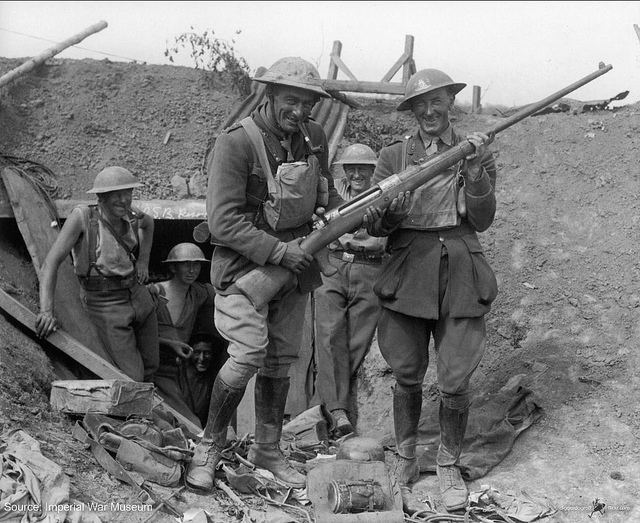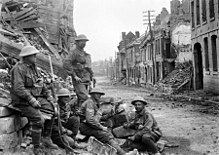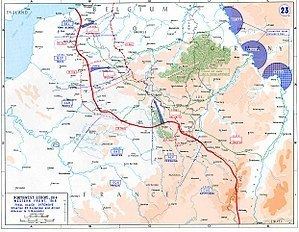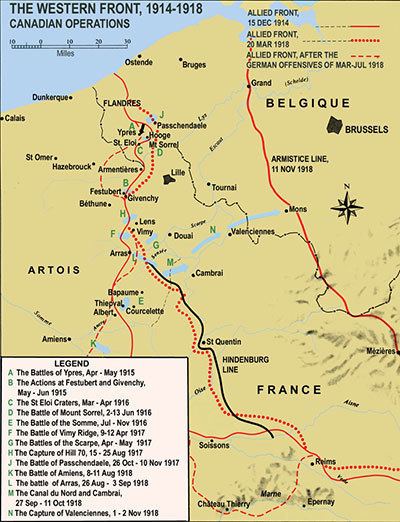Dates 8 Aug 1918 – 11 Nov 1918 | ||
 | ||
18 July – 11 Novemberc. 700,000298,000 BEF279,000 French130,000 AEF 18 July – 11 November c. 760,000386,000 captured6,700 artillery piecesBreakdownMen and materiel captured, by country BEF 188,700 prisoners, 2,840 gunsFrench 139,000 prisoners, 1,880 gunsUS 44,142 prisoners, 1,481 gunsBelgian 14,500 prisoners, 414 guns 17,5002,500 killed5,000 captured10,000 wounded Similar World War I, Western Front, Spring Offensive, Battle of Amiens, Race to the Sea | ||
World war i hundred days offensive 1 4
The Hundred Days Offensive was the final period of the First World War, during which the Allies launched a series of offensives against the Central Powers on the Western Front from 8 August to 11 November 1918, beginning with the Battle of Amiens. The offensive essentially pushed the Germans out of France, forcing them to retreat beyond the Hindenburg Line, and was followed by an armistice. The term "Hundred Days Offensive" does not refer to a specific battle or unified strategy, but rather the rapid series of Allied victories starting with the Battle of Amiens.
Contents
- World war i hundred days offensive 1 4
- World war i hundred days offensive 2 4
- Background
- The Battle of Amiens
- Somme
- Advance to the Hindenburg Line
- Battles of the Hindenburg Line
- Subsequent operations
- References

World war i hundred days offensive 2 4
Background

The Spring Offensive of the German Army on the Western Front had begun on 21 March 1918 with Operation Michael and had petered out by July. The Germans had advanced to the river Marne but failed to achieve a decisive breakthrough. When Operation Marne-Rheims ended in July, the Allied supreme commander Ferdinand Foch, ordered a counter-offensive which became known as the Second Battle of the Marne. The Germans, recognising their untenable position, withdrew from the Marne towards the north. For this victory, Foch was granted the title Marshal of France.
Foch considered the time had arrived for the Allies to return to the offensive. The American Expeditionary Force (AEF, General John J. Pershing), was present in France in large numbers and invigorated the Allied armies. Pershing was keen to use his army in an independent role. The British Expeditionary Force (BEF) had also been reinforced by large numbers of troops returned from the Sinai and Palestine Campaign and the Italian Front and replacements held back in Britain by the Prime Minister, David Lloyd George.
A number of proposals were considered and, finally, Foch agreed on a proposal by Field Marshal Sir Douglas Haig, Commander-in-Chief (C-in-C) of the BEF, to strike on the River Somme, east of Amiens and south-west of the site of the 1916 Battle of the Somme, with the intention of forcing the Germans away from the vital Amiens–Paris railway. The Somme was chosen as a suitable site for the offensive for several reasons. As in 1916, it marked the boundary between the BEF and the French armies, in this case defined by the Amiens–Roye road, allowing the two armies to cooperate. Also the Picardy countryside provided a good surface for tanks, which was not the case in Flanders. Finally, the German defences, manned by the German 2nd Army (General Georg von der Marwitz), were relatively weak, having been subjected to continual raiding by the Australians in a process termed peaceful penetration.
The Battle of Amiens

The Battle of Amiens (with the French attack on the southern flank called the Battle of Montdidier) opened on 8 August 1918, with an attack by more than 10 Allied divisions—Australian, Canadian, British and French forces—with more than 500 tanks. Through careful preparation, the Allies achieved surprise. The attack, led by the British Fourth Army, broke through the German lines and tanks attacked German rear positions, sowing panic and confusion. By the end of the day, a gap 15 mi (24 km) wide had been created in the German line south of the Somme. The Allies had taken 17,000 prisoners and 330 guns. Total German losses were estimated to be 30,000 men, while the Allies had suffered about 6,500 killed, wounded and missing. The collapse in German morale led Erich Ludendorff to dub it "the Black Day of the German Army".

The advance continued for three more days but without the spectacular results of 8 August, since the rapid advance outran the supporting artillery and ran short of supplies. During those three days, the Allies had managed to gain 12 mi (19 km) but most of that had occurred on the first day, as a result of the Germans adding reinforcements. On 10 August, the Germans began to pull out of the salient that they had managed to occupy during Operation Michael in March, back towards the Hindenburg Line.
Somme
On 15 August 1918, Foch demanded that Haig continue the Amiens offensive, even though the attack was faltering as the troops outran their supplies and artillery and German reserves were being moved to the sector. Haig refused and prepared to launch a fresh offensive by the Third Army at Albert (the Battle of Albert), which opened on 21 August. The offensive was a success, pushing the German 2nd Army back over a 34 mi (55 km) front. Albert was captured on 22 August. The attack was widened on the south, by the French Tenth Army starting the Second Battle of Noyon on 17 August, capturing the town of Noyon on 29 August. On 26 August, to the north of the initial attack, the First Army widened the attack by another 7 mi (11 km) with the Second Battle of Arras of 1918. Bapaume fell on 29 August (during the Second Battle of Bapaume).
Advance to the Hindenburg Line
With the front line broken, a number of battles took place as the Allies forced the Germans back to the Hindenburg Line. East of Amiens (after the Battle of Amiens), with artillery brought forward and munitions replenished, the Fourth Army also resumed its advance, with the Australian Corps crossing the Somme River on the night of 31 August, breaking the German lines during the Battle of Mont Saint-Quentin. On 26 August, to the north of the Somme, the First Army widened the attack by another 7 mi (11 km) with the Second Battle of Arras of 1918, which includes the Battle of the Scarpe (1918) (26 August) and the Battle of Drocourt-Queant Line (2 September).
South of the BEF, the French First Army approached the Hindenburg Line on the outskirts of St. Quentin during the Battle of Savy-Dallon (10 September), and the French Tenth Army approached the Hindenburg Line near Laon during the Battle of Vauxaillon (14 September). The British Fourth Army approached the Hindenburg Line along the St Quentin Canal, during the Battle of Épehy (18 September). By 2 September, the Germans had been forced back close to the Hindenburg Line from which they had launched their offensive in the spring.
Battles of the Hindenburg Line
Foch planned a series of concentric attacks on the German lines in France (sometimes referred to as the Grand Offensive), with the various axes of advance, designed to cut German lateral communications, intending that the success of an attack would enable the entire front line to be advanced. The main German defences were anchored on the Hindenburg Line, a series of defensive fortifications stretching from Cerny on the Aisne river to Arras. Before Foch's main offensive was launched, the remaining German salients west and east of the line were crushed at Havrincourt and St Mihiel on 12 September and at the Battle of Épehy and the Battle of the Canal du Nord on 27 September.
The first attack of the Grand Offensive was launched on 26 September by the French and the AEF in the Meuse-Argonne Offensive (this offensive includes the Battle of Somme-Py (26 September), the Battle of Saint-Thierry (30 September), the Battle of Montfaucon (14–17 October) and the Battle of Chesne of 1 November). The offensive involved attacking over difficult terrain, resulting in the Hindenburg Line not being broken until 17 October. Two days later, the Army Group under Albert I of Belgium (the Belgian Army, the British Second Army (General Herbert Plumer) and the French Sixth Army (General Degoutte), attacked near Ypres in Flanders (the Fifth Battle of Ypres). Both attacks made good progress initially but were then slowed by supply difficulties.
On 29 September, the central attack on the Hindenburg Line commenced, with the British Fourth Army led by the Australian Corps attacking in the Battle of St. Quentin Canal and the French First Army attacking fortifications outside St Quentin. By 5 October, the Allies had broken through the entire depth of the Hindenburg defences over a 19 mi (31 km) front. Rawlinson wrote, "Had the Boche [Germans] not shown marked signs of deterioration during the past month, I should never have contemplated attacking the Hindenburg line. Had it been defended by the Germans of two years ago, it would certainly have been impregnable…."
On 8 October, the First and Third British Armies broke through the Hindenburg Line at the Second Battle of Cambrai. This collapse forced the German High Command to accept that the war had to be ended. The evidence of failing German morale also convinced many Allied commanders and political leaders that the war could be ended in 1918; previously, all efforts had been concentrated on building up forces to mount a decisive attack in 1919.
Subsequent operations
Through October, the German armies retreated through the territory gained in 1914. The Allies pressed the Germans back toward the lateral railway line from Metz to Bruges, which had supplied the front in Northern France and Belgium for much of the war. As the Allied armies reached this line, the Germans were forced to abandon increasingly large amounts of heavy equipment and supplies, further reducing their morale and capacity to resist.
There were many casualties in the Allied and German armies. Rearguard actions were fought during the Pursuit to the Selle (9 October), Battle of Courtrai (14 October), Battle of Mont-d'Origny (15 October), Battle of the Selle (17 October), Battle of Lys and Escaut (French: Bataille de la Lys et de l'Escaut) (20 October) (including the subsidiary Battle of the Lys and Battle of the Escaut), Battle of the Serre (20 October), Battle of Valenciennes (1 November) and the Battle of the Sambre (including the Second Battle of Guise (4 November) and the Battle of Thiérache (4 November), with fighting continuing until the last minutes before the Armistice took effect at 11:00 on 11 November 1918. One of the last soldiers to die was Canadian Private George Lawrence Price, two minutes before the armistice took effect.
